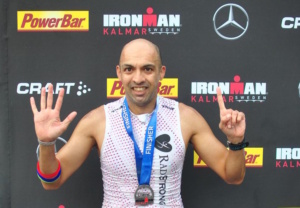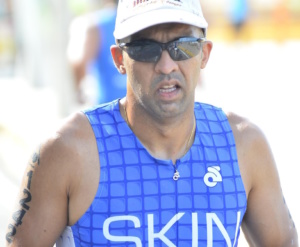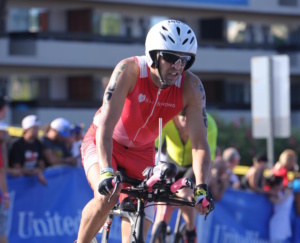While lounging in the tub one day, Kaustubh Radkar first heard of an Ironman. Ever since, the doctor trained his eyes on the race and today helps others take on the challenge.

First published:
https://www.redbull.com/in-en/kaustubh-radkar-ironman-from-pune
Meet Kaustubh Radkar, the 20-time Ironman from Pune
Former national swimming champion Kaustubh Radkar has become well-known across the world as a seasoned Ironman athlete. He tells us how he started competing in the world’s toughest triathlons
It was just another day in 2008 when Kaustubh Radkar was lying in a hot tub in Colorado. With the days of representing India on the swimming circuit in his past, he was now in the less physically-demanding pursuit of academics.
However, what was to be an idle, unwinding period for Radkar turned out to be quite the contrary. Within the next six months, he would line up at the start of his first Ironman.
“My friends had just returned from Ironman Hawaii,” Radkar says, on an overcast afternoon in Pune. “For the next hour, the conversation revolved around the entire experience of participating in an Ironman. It got me really curious and I started digging out more details.”
Among the three tasks at the Ironman, cycling was alien to him and running a new pursuit; though he had recently completed two marathons. What he was most comfortable with was water, having undergone the grind of a competitive swimmer. He began swimming at the age of eight when his mother would walk him to a swimming pool daily, just a short distance from their home near the Deccan Gymkhana area of Pune. Today, the cosy abode doubles up as his clinic and personal gym, and medals and souvenirs from the 20 Ironmans he has completed adorn his walls.
Radkar and his sister had been introduced to the pool just so that they would learn how to swim. A year later, Radkar had taken to it and lined up for his first competitive race; he finished outside the podium places routinely for the next three years. Watching other kids strut around with medals fired him up — if they could have it, so could he. But in his pursuit to start winning early, he created plans for himself which coaches thought was a ploy to cut corners in the pool.
“I didn’t work out as much as the other kids did — I just worked smarter. For instance, I identified the freestyle as my main stroke, so I put in all my energy while at it. I used the other strokes to recover. It makes sense if you think about it, but not many coaches want to have kids making these decisions around them,” he says, smiling.
His early dedication to self-learning saw him pick up medals and trophies, and also represent India at the Asia-Pacific championship. While most of his friends were chasing grades, Radkar’s folks let him pursue his calling. An average student at school, it was a swimming scholarship that helped him move to the United States after his 12th grade, where he chose to study exercise science and sports at the Indiana University in Pennsylvania.

Though he continued swimming in college, education took up most of his time. When infrastructure did not allow for a pool, running became a part of his routine in 2005. In the next two years, he ticked off a couple of marathons. By the time he had his mind set on an Ironman, he only had to figure out the cycling stage.
“The swim is the most difficult part for most — 90% (of participants) struggle in the water, and I was good at it. I was decent at running. So in March, I borrowed a friend’s bicycle and signed up for a new Ironman race that they were to launch in Arizona in November,” he recalls.
With the US Masters swimming championship wrapped up in May 2007, Radkar mounted a bike for the first time the following month. A half Ironman in June was on the cards; the goal was just to finish the race.
“I had no idea about racing. Everyone who passed me on the bike had something to tell me — ‘what are you doing, change your gears, your cadence is too fast, the seat height is not too good’. I had no technical knowledge — just a goal of finishing under six hours. I managed to finish 12 seconds short of my target,” he says.
Somewhere during the swim, Radkar tore his shoulder; the injury was aggravated in September, forcing him to miss training for two weeks. In fact, right after the Ironman in November, he was scheduled for surgery. But instead of letting these factors play on his mind, Radkar focussed on the task ahead. Starting his first Ironman with a swim only made him more confident.
“My friends had told me to line up at the front — that’s all I remember at the starting line. I was on a high by the end of it, as I was the first amateur out of the water. When your name is called out, and there’s a camera guy chasing you, and the fact that it is your first race — it really puts you in a different place,” he says.

The joy of beating the 12-hour mark with an 11.41 in his first race — despite two flats to his cycle — overpowered the searing pain of a torn muscle, this time in his other shoulder. Surgery too didn’t work out post-race; instead, Radkar targeted a second Ironman in Penticton in August 2009. It’s a race he wouldn’t forget in a hurry.
“I had an asthma attack during that one, and I didn’t even know I had the condition. Then, I picked up a knee injury, so my run was essentially a walk. I still finished it in 12.50, but I knew there was a lot that I had to learn,” he says.
He also realised that he had to do a third Ironman to set things right. Three, he thought, was an odd number, so that changed to four and soon, he had hit double digits. On 11th November 2017, Radkar finished his 20th Ironman since starting around nine years ago.
“Simply put, it’s an addiction. It puts a lot of stress on the body, but what people don’t understand is that I’ve been in the competitive space since I was nine. I’m used to the pressure and the burnout,” he says.
For five years, Radkar had a gruelling routine involving training, chasing a business degree, working at the John Hopkins hospital, and somehow finding time for rest and recovery. In the winter, the severe Baltimore weather forced him to train indoors. He could afford little leeway in preparation for an Ironman.
The races had to be carefully planned, keeping in mind the classes at school and the work schedule. Between 2008 and 2013, Radkar finished seven Ironmans, including his fastest time of 11.03 during the last one in Wisconsin.
“I was well-trained alongside a good training partner, nutrition was spot on. I had a really good day,” he says. “I think 60% of it is scientific. At the same time, the challenge of anything over four hours is that you have to be focused. One simple mistake and you will be on the floor. And getting into the zone starts for me the night before.”
It was the perfect goodbye, as he looked to move back to India after 13 years in the US. While the comfort of family and friends was great, he faced many more challenges on the training front.
“Dogs, two-wheelers — I’ve been chased by it all. Cycling outside is risky as well. Then, there is the lack of competition,” he says.
The transition in his diet was smoother, given that his preferences lie somewhere between non-fussy and balanced. On cheat days, he allows himself upma, khichdi and a regimented helping of ice cream.
“Give your tastebuds a little something — that way you won’t land up polishing a tub eventually,” he chuckles.
Alongside the training, Radkar set up a practice in exercise science to coach aspiring runners and triathletes. It provided the necessary funding to continue his pursuit of 25 Ironmans. Between March 2014 and November 2016, he travelled around the world at his own expense and raced an Ironman on six continents en route.
As 2017 came around, he had the opportunity to take on the world championship at the home of Ironman — Kona, Hawaii. After Ironman South Africa (2nd April) and Ironman Wisconsin (10th Sept) and the Berlin Marathon (24th Sept), it was finally time to tackle the prestigious race on 13th October.
“One way to qualify is to be among the top in your age group during the other Ironmans. The second is through the Legacy program (if you have never been to Kona before, and have done 12 Ironmans including one in the last two years), which is how I got in,” he says.
“It’s the birthplace of Ironman — a lot of history associated with it and an honour to race there,” he says.
However, it turned out to be one of the most disappointing races that he’s run; yet one he’s proud of accomplishing. It took something special to cross the finish line this time around.
“The swim is choppy, the weather unforgiving. There’s a lot of headwinds to deal with, a lot of climbing through the course that at one point runs through lava fields. There’s just no shade on the course, and it’s really hot, even at night,” he says.
By the time he reached the running leg, Radkar had dealt with cramps and a continuous bout of vomiting. The first kilometre of the run took all of seven minutes. There was no sense in pushing it, but at the back of his head was all the hard work over the years that had brought him there. At a time when most would resign, Radkar pushed on — walking and jogging but making slow progress. The battle was as physical as it was mental, a lot of positive self-talk and visualisation engulfed the warm Hawaiian night.
When Radkar made it across the finish line in 13.50, it was the slowest race he had run. There was the satisfaction of finishing the coveted Ironman Kona, but at the same time, this burning desire to set things right again. The following month, he beat that time by clocking 13.46 at Ironman Malaysia.
What was even more incredible was the fact that during September 2016, Radkar suffered an Anterior Cruciate Ligament (ACL) tear. Instead of a period of rehabilitation, he completed five Ironmans — including three within two months — an Ultraman and three marathons.
“Mind over matter — that’s my mantra. I had targeted 25 Ironmans and am slowly getting there. I think I’ll stop after that,” he says.
At 35 years, Radkar now divides time between his training and that of his wards. Then, there’s the joy of fatherhood that he’s enjoying these days, happy to chase his son in circles, rather than the next target.
Competing professionally has taken a backseat at the moment, but it’s just a matter of time until he gets hooked yet again, perhaps with a stolen scoop of ice-cream.